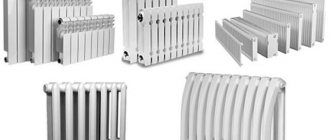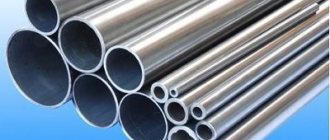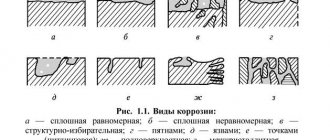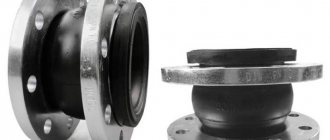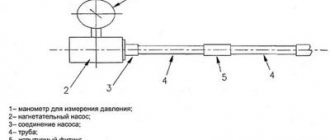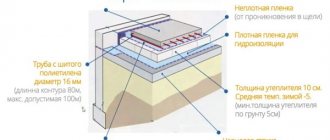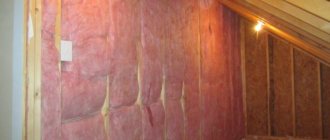Why do you need thermal insulation of pipelines?
Steel and plastic pipes used for water supply, sewerage and heating systems do not always require insulation. But in many cases it is necessary if the owners of the house are not ready to be left without water or heat in the middle of winter and spend money on repairing communications.
- Thermal insulation for water supply pipes is required if they are laid below the freezing level of the soil, on the surface of the ground, or pass through unheated rooms. Without it, the water in them will freeze in winter, which will most likely lead to damage to the pipes and components themselves. This is fraught not only with inconvenience associated with the lack of water, but also with the need for repairs, which is preceded by a search for damaged areas. In the case of steel pipes, insulation has another goal: eliminating condensation in hot weather.
Broken faucet
- Insulation of heating pipelines is also necessary when they pass through a cold zone: in walls, underground or along the street (for example, from a separate boiler room into a house). In such cases, high heat loss occurs, and the coolant reaches the consumer very cold, which negatively affects the efficiency of the heating system and increases the cost of maintaining a comfortable temperature.
The heating main in the basement needs insulation
- Insulation is least often required for gravity sewer systems, since they have an open spout and work to remove warm wastewater. The need for insulation arises if the pipes are laid shallow, with too little slope, or have a large length or turns. And also if the house is not equipped with hot water supply. Traffic jams and jams may appear in them, creating ideal conditions for freezing.
Note! Thermal insulation materials, in addition to their main function, can perform another function - sound insulation. Therefore, sometimes they are used precisely for this purpose.
Purpose of pipe insulation
Insulation materials can perform several functions at once. PPU pipe insulation technology involves the use of these products not only for insulation, but also for protection against overheating. The fact is that during pumping of the working substance it can become very hot. To prevent such an outcome, high-quality insulation is necessary. A reliable shell of sufficient thickness can also significantly reduce the noise level created by the moving liquid.
What properties should an insulating material have?
Insulation for pipes, depending on the scope of application (laying underground or external communications), must meet the following requirements:
- Low level of thermal conductivity, which will help maintain the temperature of the coolant in heating and hot water supply pipelines, as well as prevent warm ambient air from heating the pipeline in cooling devices and appliances.
- Materials used for insulation must meet sanitary and fire safety standards and have self-extinguishing properties.
- Insulation cannot be overly hygroscopic, since the amount of air in the structure of a wet material decreases, the amount of which determines its thermal insulation properties.
- Thermal insulation should be easily installed on pipes of any diameter and configuration, with the formation of a minimum number of joints, which eliminates the presence of cold bridges.
- The material must be durable and maintainable, as well as the possibility of its repeated use.
- Possess high resistance to aggressive environments, mechanical strength, and withstand sudden temperature changes.
- Material available at an affordable price.
But you shouldn’t buy cheap insulation, as this can lead to even greater costs if the pipe freezes in winter.
Gas pipeline insulation
To insulate pipes transporting gas, various types of insulators are used. For example, you can thermally insulate a gas pipeline using special paint or varnish, but in most cases modern protective materials are used.
What requirements must an insulator for gas pipes meet:
- first of all, the insulator for the gas pipeline must be able to be uniformly, monolithically mounted on the pipe;
- and it is also very important that the insulating material for the pipeline has a low coefficient of water absorption and generally high waterproofing properties;
Important! The insulating material must protect the pipe from exposure to ultraviolet radiation, since ultraviolet rays are a destructive factor.
The material for insulating gas pipes must have high moisture resistance
- also, high-quality protective material must be highly resistant to corrosion and the effects of any other aggressive chemical compounds;
- the insulator must be quite strong to protect the gas pipeline from mechanical stress;
- the coating must not have any damage (cracks, chips, etc.).
Let's consider the main types and types of gas pipeline insulation:
- bitumen mastics. Such heat insulators are produced with various additives that are mixed into the base material - bitumen. Additives can be of three types:
- Polymer.
- Mineral.
- Rubber.
Such additives provide protection against cracks and, in addition, improve adhesion to the surface of the gas pipe. It is also worth noting that bitumen mastics have proven themselves at low temperatures.
- tape materials. Insulating tapes are usually made of polyethylene or polyvinyl chloride (PVC). At the production stage, an adhesive material is applied to one side of such a tape, through which the tape is installed on the gas pipeline.
Depending on the design features of the pipeline and the region in which it is laid, the following types of tape insulation are used:
- Regular.
- Reinforced (RS).
- Very enhanced (VUS).
To protect gas pipelines today, tape insulation is often used, which is wound onto the pipes using a special device.
The latter type of insulation is the most reliable and effective and is most often used to protect pipelines in populated areas. VUS is resistant to aggressive corrosive influences and active chemicals.
VUS is produced using the extrusion method. Pipe insulation with extruded polyethylene is carried out to increase the protective functions of the pipeline. Insulating pipes with extruded polyethylene is a very reliable protection option. Extruded tapes have excellent waterproofing properties and are installed on pipes that are laid even in unfavorable climatic conditions.
Types of thermal insulation for pipelines
The above requirements may have the following types of insulation:
- types of mineral wool - glass wool, basalt and others;
- Styrofoam;
- expanded polystyrene;
- foamed polyethylene, plain and foil-coated;
- polyurethane foam;
- expanded clay
Mineral wool
Mineral wool cylinders
All types of insulating material based on fiberglass or natural rock are characterized by a high degree of thermal insulation and optimal cost. True, glass wool in its properties to retain heat is an order of magnitude lower than such a material as basalt insulation. The advantages of this type of insulation include:
- resistance to high temperatures, when the material can withstand up to 700 degrees;
- sufficient mechanical strength, when after deformation mineral wool almost completely restores its shape;
- resistance to aggressive chemicals - alkaline, acidic solutions, oils, etc.;
- environmental safety, as a derivative from natural raw materials.
- affordable price.
The disadvantages of mineral wool include their sensitivity to moisture. Therefore, an additional waterproofing layer is required. In addition, waterproofing will not only help protect the insulation from exposure to water, but will also prevent the smallest fibers of stone or glass from clogging the air in the room. Such work increases the cost of construction and extends its duration.
Mineral wool is produced in rolls, mats, slabs and shells with foil glued on top. It is these products that are most convenient for performing thermal insulation work on pipelines, when protecting wooden roof structures from fire in the area where the chimneys of stoves and fireplaces pass.
Polystyrene foam and polystyrene foam
Foam shells for pipe insulation
This material, which contains more than half air, is one of the most effective heat insulators. Non-pressed foam is bad only because it has low mechanical strength. To insulate pipes, the industry produces foam half-cylinders called shells. These products have many advantages:
- simple and quick installation;
- long-term operation;
- absence of cold bridges, since the connection of individual segments is carried out according to the tongue-and-groove principle;
- products can be operated in temperatures from +80 to -110 degrees Celsius. At a higher temperature of the pipeline, an additional layer of natural cork or basalt fiber is laid;
- the ability to lay the heating cable in specially designed grooves along the entire length of the products;
- fireproof, do not support open fire;
- foam shells can be used repeatedly.
The shells can be covered with a layer of foil, which acts as a deflector for the ceilings of air - hot or cold.
Extruded polystyrene insulation
Exactly the same half-cylinders are made from pressed (extruded) foam, which is already called expanded polystyrene or penoplex. It has similar technical characteristics, but with the same degree of thermal conductivity as foam, it has a smaller thickness, which is convenient when insulating pipes running next to walls or other structures. Penoplex has a more rigid structure and greater ductility than polystyrene foam, so it can be bent to a certain limit.
Polyethylene foam insulation materials
Insulation with foamed polyethylene having a protective foil coating
Compared to other types of insulation, foamed polyethylene has the best properties:
- The material is more durable, withstands a tensile load of 0.3 MPa, after exposure to pressure, it is somewhat deformed, but quickly returns to its original shape.
- Practically does not absorb water. Can be used in humid environments without causing corrosion on pipes.
- Resistant to exposure to materials such as cement and lime, concrete and other contacts.
- Withstands temperature changes from +90 to -60 degrees. At higher temperatures, products lose their shape.
- The material is quite fireproof. Foamed polyethylene can only ignite at an open fire temperature of 300 degrees. Moreover, during combustion the material does not release harmful toxic substances into the environment.
- Easy to install, it can serve as thermal insulation for pipes of any configuration, with a diameter of up to 150-200 mm.
- Low cost compared to polystyrene foam or polyurethane products.
It is produced in hollow cylinders up to two meters long with a wall thickness of 6 to 20 mm or in rolls.
This is how foamed polyethylene is mounted on pipes
A product made of foamed polyethylene is cut to length and placed on the pipe; the cut site is secured with a special bandage or regular tape. Some brands of polyethylene foam insulation have a protective coating of aluminum foil that acts as a reflector. If rolled material is used, it is cut into strips that are used to wrap the pipes. This method is best suited if the pipeline has many bends and different diameters in individual sections.
Polyurethane foam
Spraying polyurethane foam on pipes
This material is gaining increasing popularity in construction due to its high technical characteristics. He:
- does not rot or rust;
- can be mounted on pipes lying in the ground without any trays or channels;
- creates an absolutely hermetic shell on insulated structures;
- has low specific gravity and low thermal conductivity; service life is estimated at fifty or more years;
- resistant to weak solutions of acids and alkalis;
- has excellent adhesion to almost all materials.
Thermal insulation with polyurethane foam can be applied to pipes using various methods - spraying liquid material and rigid shell-type products. Spraying is carried out using special equipment and requires certain skills and knowledge. The shell, which has the form of two hollow half-cylinders, is mounted on pipes simply, due to the existing tongue-and-groove connecting structure, and those products that have a smooth end are secured to the pipeline with special clamps, bandages, or ordinary binding wire.
Factory applied polyurethane coating
But in addition, today ready-made pipes, on which a thermal insulating coating of polyurethane foam and a protective layer are applied at the factory, are becoming widely popular. When using such products outdoors, the protective shell is made of galvanized steel; when laying underground communications, the protection is made of polyethylene. The advantages of such pre-insulated pipes are obvious: a reduction in the construction time for communications, since the laying of utility networks no longer requires insulation work, and the quality of the insulation is checked by the factory quality control department.
Expanded clay
Another traditional representative of insulation for pipelines is expanded clay gravel. It is used primarily for insulating external water supply and sewerage networks. Since the material is free-flowing, its installation requires the construction of trays from wooden boards or the use of special concrete structures.
In addition to all of the above types of insulation, a new material for pipe insulation has recently appeared - thermal paint, which is applied in the usual way - with a brush, roller or spray. With a minimum thickness of the insulating layer, the quality of thermal insulation is quite high. But the cost of this material is also not small.
Foamed polyethylene
The temperature range at which the use of high-density polyethylene foam is allowed is from -70 to +70 °C. The upper limit is not compatible with the maximum temperature of the heating pipe, usually accepted in calculations. This means that the material is of little use as thermal insulation for pipelines, but can be used as an insulating layer over a heat-resistant one.
Polyethylene foam insulation has found virtually no alternative use as protection against freezing of water pipes. Very often it is used as a vapor barrier and waterproofing.
The material is produced in the form of sheets or in the form of a flexible thick-walled pipe. The latter form is more often used, as it is more convenient for insulating water pipes. Standard length is 2 meters. Color varies from white to dark gray. There may be a coating of aluminum foil that reflects IR radiation. The differences relate to internal diameters (from 15 to 114 mm), wall thickness (from 6 to 30 mm).
Scope of application
First of all, thermal insulation is used for heating, since there, along with preventing frost, it helps to save an expensive energy resource. It is recommended to insulate pipelines not only outside residential premises, but also inside, as well as in the boiler rooms themselves. After all, this will eliminate the energy consumption for heating non-residential rooms.
There are four main groups of insulating materials for heating communications:
- roll;
- cylindrical cut;
- cylindrical uncut;
- halves of a cylinder (format is better known as "shell").
In any case, it is necessary to calculate the installation of insulating structures for the exact diameter of the pipe. The appearance of a gap significantly reduces the effectiveness of the protection and can even lead to its failure. Important: slag mineral wool is not suitable for heating, or even for water supply or sewerage. The service life of cotton wool insulation is relatively short (it reaches 10 years only if it is completely dry and protected from mechanical factors). Foamed polymers are completely resistant to moisture and significant cooling.
All polymers are characterized by increased flammability, which significantly reduces the scope of their application. If structures made from them will be placed on large pipes, you need to choose products with 3-4 locks. For small and medium-sized pipelines, 2 locks are enough. Polyurethane foam performs better than polystyrene foam, and that is why it is recommended for the most critical pipes. Polyurethane foam insulation materials intended for heating circuits in homes are supplied exclusively as strong shells with a steel shell.
You can use polyurethane foam only with reliable protection from light. Foamed rubber with similar characteristics is recommended not for heating pipes, but for ventilation pipes.
It also works well for protecting the pipes through which the coolant flows. Important: if there is even the slightest chance of rodents, you should use glass wool. They chew through all other substances faster than you can talk about it.
As for water supply, it is necessary to insulate it mainly when pipes are forced to be laid above the freezing line. Important: if the problem is mild, you can simply increase the speed of the water flow. This is done through the use of pumps or receivers. A heating cable is also sometimes used. Cable heating is considered the most reliable and powerful way to protect against the cold.
This is the method recommended for seasonally used cottages. The supply of heat through an electric cable helps to quickly prepare the water supply for use, and when it is no longer needed, it can be stopped.
Thermal insulation itself is most often carried out by using rigid materials, these include:
- expanded polystyrene;
- Styrofoam;
- penoplex.
Both the quality of protection and cost are directly determined by density. Soft insulation is placed in the foam shell to cover possible flaws and voids. Roll insulation of water pipes is made with mineral and glass wool, furniture foam rubber, foil foam. Problems may be associated with the hygroscopicity of the materials used. In addition to protection from harmful environmental factors, you will have to think about how to secure the roll to the pipe.
Professionals note that it is easiest to insulate water pipes using segmental materials. It is this option (sometimes also called casing) that maintains the highest tightness and reliability. Another way to protect your water supply is by spraying polyurethane foam. It initially provides absolute impermeability to water. The consumption of the component used depends on the thickness of the poured layer.
When choosing an option for insulating water pipes, you must take into account the difference between pipes laid underground and above it. The difference remains even when the same type of material is used. Plastic and metal pipes require different insulation. If you need to protect the water supply on the street (under houses, in distribution wells), use any means that will maintain the necessary tightness and will not be destroyed by water.
An aboveground pipeline needs thicker protection than its underground counterpart.
The most difficult section is the one where the pipe rises to the surface. Here either the most powerful insulator is used, or weaker options are laid out in several layers. Covering the main insulating layer from moisture is achieved by wrapping it with plastic film or roofing felt. If both solutions are unacceptable, form a plastic box. In any case, care is taken to reduce to a minimum the number of joints, each of which forms a cold bridge.
The problem can be solved by laying out an insulating coating in the form of two mutually offset layers. But it’s not just the outer parts of the water supply that need to be protected from the cold. The covering of pipes connected to air conditioners also has its own subtleties. The purpose of protection in this case is to maintain the same performance of climate control equipment. When using uncovered pipelines, a considerable part of the energy is consumed through heat transfer. Calculations are made in advance and the location of the air conditioner and all associated pipes are determined. In this case, the required diameter of the insulating layer is calculated.
In most cases, channels serving climate control equipment are protected with synthetic rubber that does not have pores or polyethylene foam. But the hygroscopicity of mineral wool prevents its use in this case. It is much better to use mineral fiber products with a water-repellent layer.
Many pipelines in apartments and private houses are made of polypropylene structures.
The need to insulate them arises when placing:
- in the floor screed of the first floors;
- in floor screeds above unheated rooms;
- near external door and window openings.
It is also necessary to protect polypropylene pipelines entering the water supply and heating risers. They can be covered with basalt cylinders. But this is a rather expensive material, which limits its use. Foam is more versatile.
Another advantage of this material is the ability to use it many times in a row.
Insulating outdoor water pipes using glass wool is significantly complicated by the danger of its dust particles for the skin and respiratory system. Preparing the casings becomes a prerequisite. All metal pipes laid outside must be painted at the preparation stage. As for the insulation of sewage systems, it must be carried out in unheated rooms and in open areas. The only exception to this rule is in areas where in winter the temperature is guaranteed not to drop to negative values.
Of course, in Russia this is only a theoretical assumption, since in reality there are no such areas.
In most cases, sewer pipelines, including those from HDPE, cover:
- mineral wool in various formats;
- expanded polystyrene;
- expanded clay;
- polyurethane foam.
Liquid insulating elements are occasionally used. All such options are considered passive varieties. But sewerage, like other types of pipelines, is often protected using cable heating. Mineral wool should be used with caution to protect sewer systems because it contains formaldehyde resins and can be destroyed under significant mechanical stress. This makes it significantly more difficult to achieve effective thermal insulation.
Cotton insulation is used when it is necessary to cover the free areas of the channels. They cannot be laid in the soil. Wet cotton wool of any type very easily loses its characteristics. And if the pipes are made of metal, they often begin to rust quickly. To install it yourself, you need to use polystyrene foam.
Utility systems often include copper pipes, which have impressive practical properties. But even they need effective thermal protection. In most cases, copper pipelines are covered with foam materials. Such products are suitable not only for air conditioning ducts, but also for all water supply systems and heating lines.
Thermal insulation is also important for heated floors. As calculations show (and practice confirms), floors without insulation in an identical configuration under similar conditions consume 20% more energy. Cork substrates are widely used to stop heat flow. Their advantage is ideal environmental quality and excellent strength. Please note: cork has zero adhesion to cement screeds and blocks.
Installation of cork heat-shielding elements is possible if the ceilings allow it. Cork inevitably raises the floor by 40-50 mm. Therefore, it is unacceptable in rooms with low walls. The most popular method of thermal protection for heated floors is extruded polypropylene. The structure of its plates contains closed cells.
Polypropylene is well processed, it will not be difficult to install it even where the floor configuration is very sophisticated. In addition, the synthetic material does not absorb water and can be used at temperatures up to 130 degrees. Water-heated floors are mainly protected using polystyrene foam. Important: when choosing polymer structures, you need to carefully study their chemical composition. Sometimes it contains toxic components that will be released when heated.
To complete the overview of the areas of application of thermal insulation, it is appropriate to protect chimney pipes placed inside walls.
Help prevent heat loss and damage to the chimney from condensation:
- mineral wool;
- fiber products;
- slag concrete and structures based on it;
- brick break;
- foam glass.
Materials that are easily flammable and can be destroyed by heat are naturally prohibited. Professional builders try to use cinder blocks. This option is quite heavy and requires careful design taking into account the load on the roofing and load-bearing elements.
For independent work, flexible and soft mineral wool is much better suited. Attention: no matter what, where and with what is insulated, it is necessary to take into account the instructions for pipelines and insulating materials.
General information
The choice of pipeline casing largely depends on the type of installation. There are three laying options:
| Underground in channels | In this case, the pipeline is most protected from adverse environmental influences. The only thing is that insulation of heating pipes and a hot water supply system are required to preserve the thermal energy of the transported liquid. If the channels are located above the soil freezing level, then thermal insulation is also required for ordinary water supply. |
| Underground ductless | It involves laying the system directly into the ground. Accordingly, the pipeline needs protection from the effects of groundwater, etc. |
| Overground | In this case, the structure is exposed to all atmospheric influences, as a result of which it requires anti-corrosion and, most often, thermal insulation. |
If the coating is selected incorrectly or applied in violation of the technology, this can lead to failure of the system, the need for urgent repair or even complete replacement.
Bitumen insulation
Pipe insulation technology
With the advent of thermal insulation cylinders, the insulation process itself has become very simple. Even an inexperienced beginner can do it with his own hands. To do this, it is necessary to select the correct shell according to the diameter of the pipe being insulated; its internal diameter must coincide with the external diameter of the pipeline. Pipes of small diameter are insulated with cylinders with a longitudinal dimension. The insulation procedure itself is quite simple - you need to put the material on the pipe, after which the cut ends are covered with protective tape or glued to each other.
It is necessary to ensure complete sealing of the seam. The joints of the two cylinders are connected to each other with the same tape or tape.
If thermal insulation of large diameter pipes is being carried out, then it is necessary to use cylinders of two or three parts. They are laid on the outer plane of the pipe so that they form a closed cylinder. The parts are fastened with tape, tape, wire or clamps. The distance between the fasteners is 30-50 cm. The joint between the two finished shells must be covered with tape or tape. The tightness of the joint between the parts of the insulation is ensured by a locking connection.
How to properly insulate pipes outdoors
The most dangerous areas prone to freezing in winter are those located outdoors. In principle, the technology for carrying out the thermal insulation process is practically no different from insulating pipes indoors. But, as mentioned above, many heat insulators lose their thermal insulation properties under the influence of sunlight and humidity, so pipes insulated outdoors are additionally covered with protective layers.
Algorithm of work carried out:
- If the pipes are metal, they must be painted or treated with bitumen mastic. If they are plastic, then you don’t need to do anything.
- Insulation is being installed. The thicker it is, the better. Using roll materials, installation must be carried out in several layers. The minimum thickness is 10 cm. For example, cylinders made of polyurethane foam are produced with a thickness of up to 720 mm.
- Fastening is done with foil tape.
- A protective coating is installed. This can be roofing felt laid in several layers, a galvanized steel casing, a plastic or rubber casing, an asbestos coating with a reinforcing metal mesh.
Today, plastic casings for small-diameter pipes are increasingly used as a protective layer. This is practically the same cylinder with a longitudinal section. There is no need to attach it to the insulation; simply tie it with wire in two or three places. Large diameter pipes are most often protected with metal casings. Often outdoors, combined insulation is used: roofing felt and a metal casing.
As you can see, there are a lot of insulation materials for pipeline insulation. All of them are quite effective, and the method of installation is very simple, which pleases home craftsmen who are accustomed to doing everything in the house with their own hands. And the appearance of heat-insulating cylinders on the market reduced this insulation process to a minimum.
Pre-insulated pipes
This method of pipeline insulation is considered the most promising. The method consists of filling the space between the insulated pipe and a larger pipe with polyurethane foam. The result is a monolithic three-layer structure with excellent thermal and waterproofing properties.
Comparative analysis of technical and economic efficiency when using polyurethane foam products and traditional mineral wool
Indicators Polyurethane foam Mineral wool
| Coefficient of thermal conductivity | 0,019-0,027 | 0,05-0,07 |
| Coating thickness | 35-70 mm | 120-220 mm |
| Effective service life | 25-30 years | 5 years |
| Manufacturing jobs | From 5°C to 30°C | From 5°C to 30°C |
| Moisture, aggressive environments | Stable | Thermal insulation properties are lost and cannot be restored |
| Ecological cleanliness | Safe. Approved for use in residential buildings by the Ministry of Health of the RSFSR No. 07/6-561 dated December 26, 1986 | Allergen |
| Productivity brigade 2 - people | 100-300 m.p. per shift | 20-5 - m2 per shift |
| Actual heat loss | 1.7 times lower than the normative SNiP 2.04.14 88 Energy Saving, No. 1, 1999 | Exceeding regulatory standards after 12 months of operation |
| Technological advantages | Transition to ductless installation of heating networks SNiP 2.04.07-86 (heat networks) SNiP 2.04.17-88 (thermal insulation of equipment and pipelines) TU RB 00012262-181-94 <products made of="" polyurethane foams=""> SNiP 11 -3-79 (Construction heating engineering) TU 3497-44406476001-99 | No |
Thermal insulation Average density (kg/m 3) Thermal conductivity coefficient (W/m*K) Porosity Service life (years) Operating temperature range.
| Polyurethane foam (PPU) | 40-60 | 0,019-0,027 | Closed | 30 | -200°С +120°С |
| Mineral wool | 55-150 | 0,052-0,058 | Open | 5 | -40°С +120°С |
| Cork board | 220-240 | 0,050-0,060 | Closed | 3 | -30°С +90°С |
How to choose?
As you might guess, careful calculation of the diameter of heat-protective structures is of great importance. It is very difficult to determine the exact thickness of the insulating cylindrical part. Sometimes you have to turn to professionals to eliminate serious mistakes. But there is a way to do everything yourself, you just need to refer to the normal levels of heat loss. Such levels are fixed in SNiP and differ for each pipeline diameter and for each installation method.
Calculation in accordance with the set of rules, including for pipes with a cross-section of 32 mm, is noticeably simpler than in accordance with the instructions in professional technical literature. Simplifications are due to the fact that the heat consumption for heating the pipe walls is ignored. All the same, its real value is small if we take into account the consumption of thermal energy to warm up the external insulation. If piping is made of steel, copper or cast iron, resistance to heat transfer is not taken into account.
It is very difficult to select a heat-protective layer when a medium heated to 300 degrees or more moves through the pipe. Even those substances that can withstand such a thermal load transmit a lot of heat. The total thickness of the insulating layer sometimes turns out to be excessive, so it is recommended to form a “layer cake”. The closest material to the pipe is a material that stops the destructive effects of heat. Only after it is created a different coating that prevents hypothermia.
When calculating and selecting, and during subsequent installation of thermal insulation, it is necessary to ensure that the temperature at the intersection of the layers does not interfere with the work of the external material. It is very important to take into account the degree of flammability of the selected insulator. Thus, thermal protection of categories G4 and G3 cannot be used together with gas pipes. It is also not suitable for any pipes located inside houses. It is recommended from the outset to limit yourself to only those materials that comply with the provisions of the regulations for a particular object.
From consumer considerations, it is not difficult to derive selection requirements such as:
- ease of installation;
- duration of use;
- affordability;
- pipe sealing;
- resistance to moisture.
Often these qualities conflict with each other. Then you have to give preference to the most significant parameters in a particular case. Polystyrene foam is low cost and can be used in its pure form or in conjunction with external protection. Trays are not required when laying out the material.
But when selecting a specific batch of insulation, it is worth remembering that the shells must be mutually offset by at least 20 cm.
Foamed polyethylene is recommended for self-insulation of water supply and sewerage systems. The specific materials do not matter; even a pipeline assembled from dissimilar sections can be insulated. Glass fiber, often sold under the name glass wool, is advisable to use on plastic contours with low initial thermal conductivity. But even under normal conditions of use, you will have to carefully protect the insulator from exposure to water. Therefore, the profitability of such a choice is questionable, and the total operating time increases.
As for penofol, its advantage can be considered versatility - the ability to protect a wide variety of pipeline systems. Designs on this basis are easy to use. The same cannot be said about polyurethane foam. Shells made from it must be mounted directly onto the pipe, that is, the work is performed only by professionals. But it will be possible to avoid heat loss from pipelines of any cross-section.
Types of materials for thermal insulation of heating pipes
Technical solutions for pipe insulation differ in design, materials and characteristics.
Mineral wool
Technical insulation made from basalt rock wool for insulation of high-temperature pipelines is produced in wound cylinders, slabs and mats, including those with one-sided foil. It is chemically inert, biostable, non-flammable, has a thermal conductivity of about 0.04 W/m*K and a density of 100-150 kg/m3.
The materials are effective, affordable, but have disadvantages. The use of mineral wool insulation for insulating heating pipes in attics, basements, and technical undergrounds is limited due to high humidity. The tendency to caking and absorption of moisture lead to structural damage, wetting, and rapid deterioration of heat-protective properties.
Installation
The pipe is wrapped or lined with cotton wool, ensuring uniform filling density over the entire surface. Then the insulation, without too much pressure, is fixed using a knitting wire. The material is hygroscopic and easily gets wet, so insulation of external pipelines made of mineral or glass wool requires the installation of a vapor barrier layer made of a material with low vapor permeability: roofing felt or polyethylene film.
Types of insulation
Today, when laying pipelines, the following types of insulating materials are much more often used:
- Bitumen;
- Folgoizol;
- Polyurethane foam shell;
- PPU shell;
- Glass wool;
- Mineral wool;
- Rubber shell;
- Polyethylene anti-corrosion insulation.
Now let's take a closer look at any of them.
Bitumen
Until recently, bitumen insulation of steel pipes was the most common. It consists of a narrow layer of polyethylene, which is protected by a bitumen coating. In addition, fiberglass is usually used on top of this coating.
Bitumen waterproofing of pipes is designed to protect the steel surface from corrosion, which may be caused by its contact with the soil and various chemical elements found in the soil. Much more often, this method is used to cover highways that are laid in sandy, rocky or clayey soil.
Note! The average operating temperature of a bitumen-coated system must be between -40 and +65 degrees Celsius.
Folgoizol
Folgoizol can also be classified as a bitumen coating, since it is made up of narrow aluminum foil and bitumen-rubber binder.
